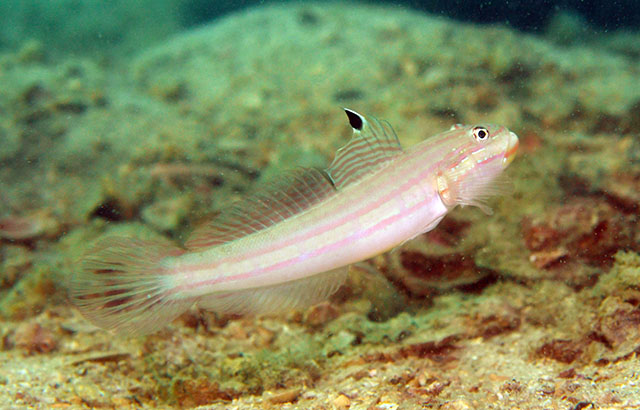| Gobiidae (Gobies), subfamily: Gobiinae |
| 16 cm SL (male/unsexed); max. reported age: 1 years |
|
reef-associated; marine; depth range 1 - 15 m |
| Indo-West Pacific: widely distributed in the eastern Indian Ocean and western tropical Pacific. |
|
Dorsal spines (total): 7-7; Dorsal soft rays (total): 12-12; Anal spines: 1-1; Anal soft rays: 12-12. Has 2 to 3 blue-bordered red longitudinal stripes on the head that extends faintly on the body, as well as red basal stripes on the dorsal and anal fins, a dark tip on the first dorsal fin, and red ocelli on the caudal fin; characterized further by pale grey body color on back, grading to white on lower side; without filamentous dorsal spines; rhomboid caudal fin, longer than head; length of caudal fin 2.8-3.5 in SL; longitudinal scale series 73-94; ctenoid body scales, becoming cycloid anteriorly below anterior part of fist of first dorsal fin; head or midline of nape without scales; side of nape with scales extending forward above middle to front of operculum; base of pectoral fin scaleless; usually partly scaled prepelvic area in adult; depth of body 5.1-6.2 in SL (Ref. 90102). |
| Inhabits shallow coastal sand and rubble flats, often near mangroves (Ref. 48637). Occur in areas of fine sand in shallow lagoon reefs. Adults occur in pairs while juveniles were often seen in small groups. Feed on small invertebrates by sifting mouthfuls of sand. Monogamous (Ref. 52884). Oviparous (Ref. 205). Breeding pairs are commonly found sharing a single burrow (Ref. 56281). |
|
Least Concern (LC); Date assessed: 20 June 2017 Ref. (130435)
|
| harmless |
Source and more info: www.fishbase.org. For personal, classroom, and other internal use only. Not for publication.
